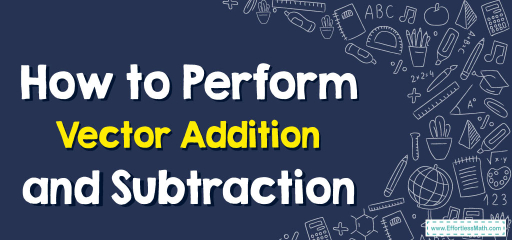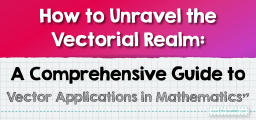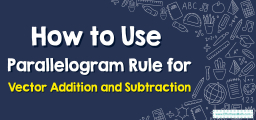How to Perform Vector Addition and Subtraction
Vector addition and subtraction are fundamental operations in vector algebra used to combine or differentiate vectors. Let's break down the concepts.

Step-by-step Guide to Perform Vector Addition and Subtraction
Here is a step-by-step guide to perform vector addition and subtraction:
Prelude: Grasping the Essence of Vectors
- Vector Definition: A vector is a mathematical entity with both magnitude and direction. They are often depicted as arrows where the length represents the magnitude and the arrow’s direction denotes its direction.
- Vector Components: In a Cartesian coordinate system, a vector in two dimensions can be represented as \(v=(v_x, v_y)\), where \(v_x\) and \(v_y\) are the \(x\) and \(y\) components respectively.
Chapter I: Vector Addition – The Confluence of Magnitudes and Directions
- Component-wise Addition: To add two vectors, combine their individual components.
- \(v+w=(v_x + w_x, v_y + w_y)\)
- Graphical Method:
- Initiation: Draw the first vector starting from the origin.
- Continuation: From the head of the first vector, draw the second vector.
- Conclusion: The resultant vector (sum) starts from the origin and ends at the head of the second vector.
- Summarizing the Process: The process is akin to walking a certain distance in one direction (first vector) and then continuing from there in another direction (second vector).
Chapter II: Vector Subtraction – The Divergence of Pathways
- Component-wise Subtraction: Subtracting vectors is analogous to addition but involves taking away magnitudes.
- \(v+w=(v_x – w_x, v_y – w_y)\)
- Graphical Method:
- Initiation: Begin by drawing the first vector, \(v\), starting from the origin.
- Introduction of the Negative Vector: Visualize or sketch the negative of the second vector, \(−w\). This is a vector of the same magnitude as \(w\) but in the opposite direction.
- Continuation: From the head of \(v\), draw \(−w\).
- Conclusion: The resultant vector (difference) begins at the origin and ends at the head of \(−w\).
- Summarizing the Process: Imagine retracing a portion of a journey. You take your entire journey (first vector) and then move backward by the path denoted by the second vector.
Postlude: Reflecting on Operations
- Vectors, with their dual nature of magnitude and direction, offer an elegant way to describe physical quantities. When we combine or separate vectors, we’re essentially juggling these two properties in a dance of mathematical harmony.
- Practicing these operations on varied vectors will solidify your understanding and enhance your ability to navigate the world of vector operations.
Examples:
Example 1:
Given vectors \(a=(5,3)\) and \(b=(−2,7)\), find \(a+b\).
Solution:
\(a+b=(a_x + \ b_x, a_y + \ b_y)=(5+(−2),3+7) =(3,10)\)
So, \(a+b=(3,10)\).
Example 2:
Given vectors \(p=(7,2)\) and \(q=(4,5)\), find \(p−q\).
Solution:
To subtract vector \(q\) from vector \(p\), we subtract the respective components of the two vectors.\(p−q=(p_x−\ q_x, p_y−\ q_y)=(7−4,2−5)=(3,−3)\)
Thus, \(p−q=(3,−3)\).
Related to This Article
More math articles
- Intelligent Math Puzzle – Challenge 79
- 10 Most Common 4th Grade Georgia Milestones Assessment System Math Questions
- How to Determine Limits Using the Squeeze Theorem?
- How to Interpret Pie Graphs? (+FREE Worksheet!)
- Distinguishing Angles: Acute, Right, Obtuse, and Straight
- The Ultimate Algebra 2 Course
- Overview of ATI TEAS 7 Mathematics Test
- 5th Grade Common Core Math Worksheets: FREE & Printable
- Overview of the ISEE Upper-Level Mathematics Test
- The Ultimate 6th Grade SOL Math Course (+FREE Worksheets)


























What people say about "How to Perform Vector Addition and Subtraction - Effortless Math: We Help Students Learn to LOVE Mathematics"?
No one replied yet.